Magnetic and Magnetoelectric Properties of AurivilliusThree- and Four-Layered Intergrowth Ceramics
Abstract
:1. Introduction
- Doping A-site with rare earth (RE) ions.
- Magnetic ion (Co/Fe) doping at B (Ti)-site.
- Adopting the intergrowth method between two different layer compounds.
2. Materials and Methods
3. Results
3.1. Powder X-ray Diffraction and Morphological Studies
3.2. Raman Spectroscopic Studies
3.3. Ferroelectric Studies
3.4. Magnetic Studies
- At low temperatures, the M-H loop resembles with ferromagnetic (FM) hysteresis loop.
- At higher magnetic fields, the magnetization shows linear behavior with the magnetic field.
- At higher magnetic fields, magnetization vs. magnetic field data shows a linear increase due to nearby magnetic ion interaction, namely iron (Fe) and cobalt (Co).
- The strength of magnetic nature can be understood by the law approach to saturation. This gives additional information about anisotropic properties.
3.5. Magnetoelectric Studies
4. Conclusions
Author Contributions
Funding
Data Availability Statement
Acknowledgments
Conflicts of Interest
References
- Subbarao, E.C. A Family of Ferroelectric Bismuth Compounds. J. Phys. Chem. Solids 1962, 23, 665–676. [Google Scholar] [CrossRef]
- Sun, S.; Yin, X. Progress and Perspectives on Aurivillius-type Layered Ferroelectric Oxides in Binary Bi4Ti3O12-BiFeO3 System for Multifunctional Applications. Crystals 2021, 11, 23. [Google Scholar] [CrossRef]
- Sun, J.; Han, Y.; Gao, G.; Yang, J.; Zhang, Y.; Dai, Y.; Song, D. Breakdown Field Enhancement and Energy Storage Performance in Four-Layered Aurivillius Films. Ceram. Int. 2022, 48, 15780–15784. [Google Scholar] [CrossRef]
- Gao, X.; Gu, H.; Li, Y.X.; Yi, Z.G.; Čeh, M.; Žagar, K. Structural Evolution of the Intergrowth Bismuth-Layered Bi7Ti4NbO21. J. Mater. Sci. 2011, 46, 5423–5431. [Google Scholar] [CrossRef]
- Ramana, E.V.; Prasad, N.V.; Tobaldi, D.M.; Zavašnik, J.; Singh, M.K.; Hortigüela, M.J.; Seabra, M.P.; Prasad, G.; Valente, M.A. Effect of Samarium and Vanadium Co-Doping on Structure, Ferroelectric and Photocatalytic Properties of Bismuth Titanate. RSC Adv. 2017, 7, 9680–9692. [Google Scholar] [CrossRef]
- Noguchi, Y.; Miyayama, M.; Kudo, T. Ferroelectric Properties of Intergrowth Bi4Ti3O12-SrBi4Ti4O15 Ceramics. Appl. Phys. Lett. 2000, 77, 3639–3641. [Google Scholar] [CrossRef]
- Parida, G.; Bera, J. Electrical Properties of Niobium Doped Bi4Ti3O12-SrBi4Ti4O15 Intergrowth Ferroelectrics. Ceram. Int. 2014, 40, 3139–3144. [Google Scholar] [CrossRef]
- Zhang, D.L.; Huang, W.C.; Chen, Z.W.; Zhao, W.B.; Feng, L.; Li, M.; Yin, Y.W.; Dong, S.N.; Li, X.G. Structure Evolution and Multiferroic Properties in Cobalt Doped Bi4NdTi3Fe1-xCoO15-Bi3NdTi2Fe1-xCoxO12-δ Intergrowth Aurivillius Compounds. Sci. Rep. 2017, 7, 43540. [Google Scholar] [CrossRef]
- Paul, J.; Bhardwaj, S.; Sharma, K.K.; Kotnala, R.K.; Kumar, R. Room-Temperature Multiferroic Properties and Magnetoelectric Coupling in Bi4-xSmxTi3-xCoxO12-δ Ceramics. J. Mater. Sci. 2014, 49, 6056–6066. [Google Scholar] [CrossRef]
- Rehman, F.; Li, J.B.; Dou, Y.K.; Zhang, J.S.; Zhao, Y.J.; Rizwan, M.; Khalid, S.; Jin, H.B. Dielectric Relaxations and Electrical Properties of Aurivillius Bi3.5La0.5Ti2Fe0.5Nb0.5O12 Ceramics. J. Alloys Compd. 2016, 654, 315–320. [Google Scholar] [CrossRef]
- Bai, W.; Yin, W.; Yang, J.; Tang, K.; Zhang, Y.; Lin, T.; Meng, X.; Duan, C.G.; Tang, X.; Chu, J. Cryogenic Temperature Relaxor-like Dielectric Responses and Magnetodielectric Coupling in Aurivillius Bi5Ti3FeO15 Multiferroic Thin Films. J. Appl. Phys. 2014, 116, 084103. [Google Scholar] [CrossRef]
- Nazemian, M.; Khoshnoud, D.S. The Enhanced of Magnetic and Electrical Properties of Bi5FeTi3O15 Compound with Replacing Co for Ti Sites. J. Magn. Magn. Mater. 2023, 565, 170243. [Google Scholar] [CrossRef]
- Paul, J.; Bhardwaj, S.; Sharma, K.K.; Kotnala, R.K.; Kumar, R. Room Temperature Multiferroic Properties and Magnetoelectric Coupling in Sm and Ni Substituted Bi4-XSmxTi3-XNiXO12±δ (x = 0, 0.02, 0.05, 0.07) Ceramics. J. Appl. Phys. 2014, 115, 204909. [Google Scholar] [CrossRef]
- Yang, F.J.; Su, P.; Wei, C.; Chen, X.Q.; Yang, C.P.; Cao, W.Q. Large Magnetic Response in (Bi4Nd)Ti3(Fe0.5Co0.5)O15 Ceramic at Room-Temperature. J. Appl. Phys. 2011, 110, 126102. [Google Scholar] [CrossRef]
- Yin, Y.; Liu, F.; Mao, X.; Wang, W. Multiferroic Properties of Bi5.75R0.25Fe1.4Ni0.6Ti3O18 (R = Eu, Sm, Nd, Bi and La) Ceramics. J. Rare Earths 2022, 40, 112–117. [Google Scholar] [CrossRef]
- Alkathy, M.S.; Rahman, A.; Zabotto, F.L.; Milton, F.P.; Raju, K.C.J.; Eiras, J.A. Room-Temperature Multiferroic Behaviour in Co/Fe Co-Substituted Layer-Structured Aurivillius Phase Ceramics. Ceram. Int. 2022, 48, 30041–30051. [Google Scholar] [CrossRef]
- Babu, B.S.; Babu, S.N.; Prasad, G.; Kumar, G.S.; Prasad, N.V. Structure and Dielectric Properties of Sm3+ Modified Bi4Ti3O12-SrBi4Ti4O15 Intergrowth Ferroelectrics. Process. Appl. Ceram. 2020, 14, 260–267. [Google Scholar] [CrossRef]
- Kharitonova, E.P.; Voronkova, V.I. Synthesis and Electrical Properties of Mixed-Layer Aurivillius Phases. Inorg. Mater. 2007, 43, 1340–1344. [Google Scholar] [CrossRef]
- Wang, L.; Gui, M.; Jin, H.B.; Hu, X.; Zhao, Y.; Adnan, N.M.; Li, J.B. Temperature Dependent Conductivity of Bi4Ti3O12 Ceramics Induced by Sr Dopants. J. Adv. Ceram. 2018, 7, 256–265. [Google Scholar] [CrossRef]
- Kikuchi, T.; Watanabe, A.; Uchida, K. A Family of Mixed-Layer Type Bismuth Compounds; Pergamon Press, Inc.: Oxford, UK, 1977; Volume 12. [Google Scholar]
- Hou, R.Z.; Chen, X.M.; Wu, S.Y. Substitution of Sm3+ and Nd3+ for Bi3+ in SrBi8Ti7O27 Mixed Aurivillius Phase. Jpn. J. App. Phys. Part 1 Regul. Pap. Short Notes Rev. Pap. 2003, 42, 5169–5171. [Google Scholar] [CrossRef]
- Zurbuchen, M.A.; Podraza, N.J.; Schubert, J.; Jia, Y.; Schlom, D.G. Synthesis of the Superlattice Complex Oxide Sr5Bi4Ti8O27 and Its Band Gap Behavior. Appl. Phys. Lett. 2012, 100, 223109. [Google Scholar] [CrossRef]
- Yan, J.; Hu, G.D. Enhanced Ferro-and Piezoelectric Properties of Bi4Ti3O12-CaBi4Ti4O15 Thin Film on Pt(111)/Ti/SiO2/Si Substrate. Mater. Res. Express 2018, 5, 056306. [Google Scholar] [CrossRef]
- Zhao, Y.; Li, Y.; Lu, Y.; Wang, Y. The Formation Mechanism of Intergrowth Bismuth Layer-Structured Ferroelectric Bi4Ti3O12-CaBi4Ti4O15. Ferroelectrics 2010, 404, 45–49. [Google Scholar] [CrossRef]
- Jiang, Y.; Jiang, X.; Chen, C.; Nie, X.; Huang, X.; Jiang, X.; Zhuang, J.; Zheng, L.; Chen, Z. Effect of Tantalum Substitution on the Structural and Electrical Properties of BaBi8Ti7O27 Intergrowth Ceramics. Ceram. Int. 2020, 46, 8122–8129. [Google Scholar] [CrossRef]
- Wang, G.; Yang, H.; Wang, J.; Sun, S.; Fu, Z.; Zhai, X.; Peng, R.; Knize, R.J.; Lu, Y. Engineering the Exchange Bias and Bias Temperature by Modulating the Spin Glassy State in Single Phase Bi9Fe5Ti3O27. Nanoscale 2017, 9, 8305–8313. [Google Scholar] [CrossRef]
- Lomanova, N.A. Aurivillius Phases Bim+ 1Fem– 3Ti3O3m+ 3: Synthesis, Structure, and Properties (a Review). Russ. J. Inorg. Chem. 2022, 67, 741–753. [Google Scholar] [CrossRef]
- Liu, F.; Jiang, X.; Chen, C.; Nie, X.; Huang, X.; Chen, Y.; Hu, H.; Su, C. Structural, Electrical and Photoluminescence Properties of Er3+ -Doped SrBi4Ti4O15—Bi4Ti3O12 Inter-Growth Ceramics. Front. Mater. Sci. 2019, 13, 99–106. [Google Scholar] [CrossRef]
- Jiang, Y.; Jiang, X.; Chen, C.; Chen, Y.; Jiang, X.; Tu, N.; Xia, X.; Luo, Y.; Zhu, S. Structural and Electrical Properties of La3+-Doped Na0.5Bi4.5Ti4O15-Bi4Ti3O12 Inter-Growth High Temperature Piezoceramics. Ceram. Int. 2017, 43, 6446–6452. [Google Scholar] [CrossRef]
- Graves, P.R.; Hua, G.; Myhra, S.; Thompson, J.G. The Raman Modes of the Aurivillius Phases: Temperature and Polarization Dependence. J. Solid State Chem. 1995, 114, 112–122. [Google Scholar] [CrossRef]
- Silva, P.H.T.; Silva, M.A.S.; da Silva, R.B.; Correa, M.A.; Bohn, F.; de Menezes, A.S.; Ferreira, W.C.; Ayala, A.P.; Sombra, A.S.B.; Fechine, P.B.A. Effects of the Bi3+ Substitution on the Structural, Vibrational, and Magnetic Properties of Bismuth Layer-Structured Ferroelectrics. Appl. Phys. A 2020, 126, 653. [Google Scholar] [CrossRef]
- Venkata Ramana, E.; Figueiras, F.; Graça, M.P.F.; Valente, M.A. Observation of Magnetoelectric Coupling and Local Piezoresponse in Modified (Na0.5Bi0.5)TiO3–BaTiO3–CoFe2O4 Lead-Free Composites. Dalton Trans. 2014, 43, 9934–9943. [Google Scholar] [CrossRef] [PubMed]
- Veenachary, V.; Puli, V.S.; Babu, S.N.; Prasad, G.; Prasad, N.V. Electrical and Magnetic Studies on Promising Aurivillius Intergrowth Compound. J. Mater. Sci. Mater. Electron. 2022, 33, 22614–22627. [Google Scholar] [CrossRef]
- Rodríguez Aranda, M.D.C.; Rodríguez-Vázquez, Á.G.; Salazar-Kuri, U.; Mendoza, M.E.; Navarro-Contreras, H.R. Raman Effect in Multiferroic Bi5Fe1+xTi3−xO15 Solid Solutions: A Temperature Study. J. Appl. Phys. 2018, 123, 084101. [Google Scholar] [CrossRef]
- Basheer, M.A.; Gangadhar, V.; Prasad, G.; Kumar, G.S.; Prasad, N.V. Electrical and Raman Spectroscopic Studies on Aurivillius Layered-Pervoskite Ceramics. Adv. Mater. Res. 2019, 1154, 80–90. [Google Scholar] [CrossRef]
- Wang, C.H.; Liu, Z.F.; Yu, L.; Tian, Z.M.; Yuan, S.L. Structural, Magnetic and Dielectric Properties of Bi5-XLa XTi3Co0.5Fe0.5O15 Ceramics. Mater. Sci. Eng. B Solid State Mater. Adv. Technol. 2011, 176, 1243–1246. [Google Scholar] [CrossRef]
- Bobić, J.; Ilić, N.; Veerapandiyan, V.; Petrović, M.V.; Deluca, M.; Dzunuzović, A.; Vukmirović, J.; Ning, K.; Reichmann, K.; Tidrow, S. Tailoring the Ferroelectric and Magnetic Properties of Bi5Ti3FeO15 Ceramics by Doping with Co and Y. Solid State Sci. 2022, 123, 106802. [Google Scholar] [CrossRef]
- Wang, G.; Huang, Y.; Sun, S.; Wang, J.; Peng, R.; Lu, Y.; Tan, X. Layer Effects on the Magnetic Behaviors of Aurivillius Compounds Bin+1Fen-3Ti3O3n+1 (n = 6, 7, 8, 9). J. Am. Ceram. Soc. 2016, 99, 1318–1323. [Google Scholar] [CrossRef]
- Ti, R.; Lu, X.; He, J.; Huang, F.; Wu, H.; Mei, F.; Zhou, M.; Li, Y.; Xu, T.; Zhu, J. Multiferroic Properties and Magnetoelectric Coupling in Fe/Co Co-Doped Bi3.25La0.75Ti3O12 Ceramics. J. Mater. Chem. C Mater. 2015, 3, 11868–11873. [Google Scholar] [CrossRef]
- Komogortsev, S.V.; Iskhakov, R.S. Law of Approach to Magnetic Saturation in Nanocrystalline and Amorphous Ferromagnets with Improved Transition Behavior between Power-Law Regimes. J. Magn. Magn. Mater. 2017, 440, 213–216. [Google Scholar] [CrossRef]
- Devi, E.C.; Soibam, I. Law of Approach to Saturation in Mn–Zn Ferrite Nanoparticles. J. Supercond. Nov. Magn. 2019, 32, 1293–1298. [Google Scholar] [CrossRef]
- Yu, Z.; Meng, X.; Zheng, Z.; Lu, Y.; Chen, H.; Huang, C.; Sun, H.; Liang, K.; Ma, Z.; Qi, Y.; et al. Room Temperature Multiferroic Properties of Rare-Earth-Substituted Aurivillius Phase Bi5Ti3Fe0.7Co0.3O15 Ceramics. Mater. Res. Bull. 2019, 115, 235–241. [Google Scholar] [CrossRef]
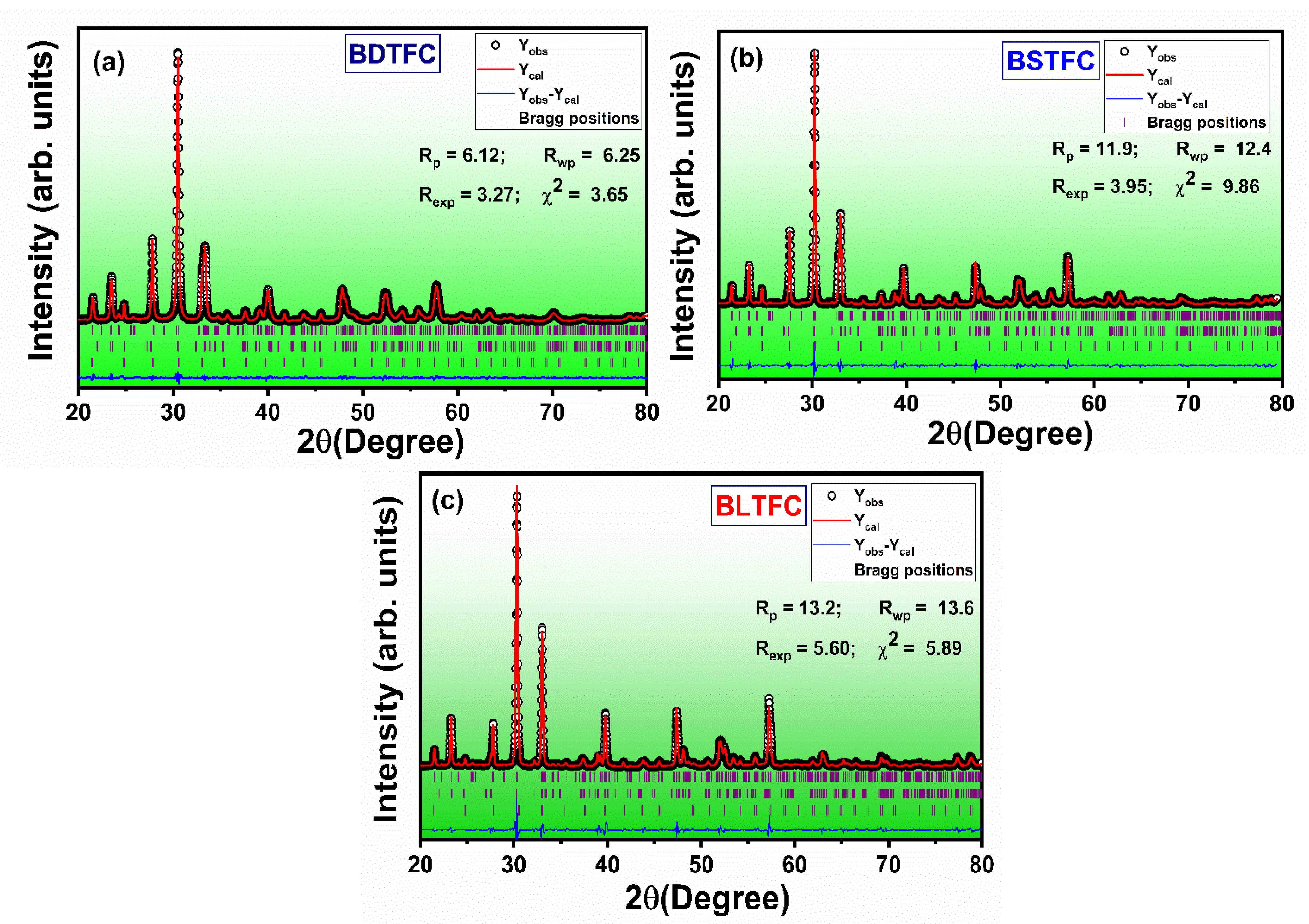
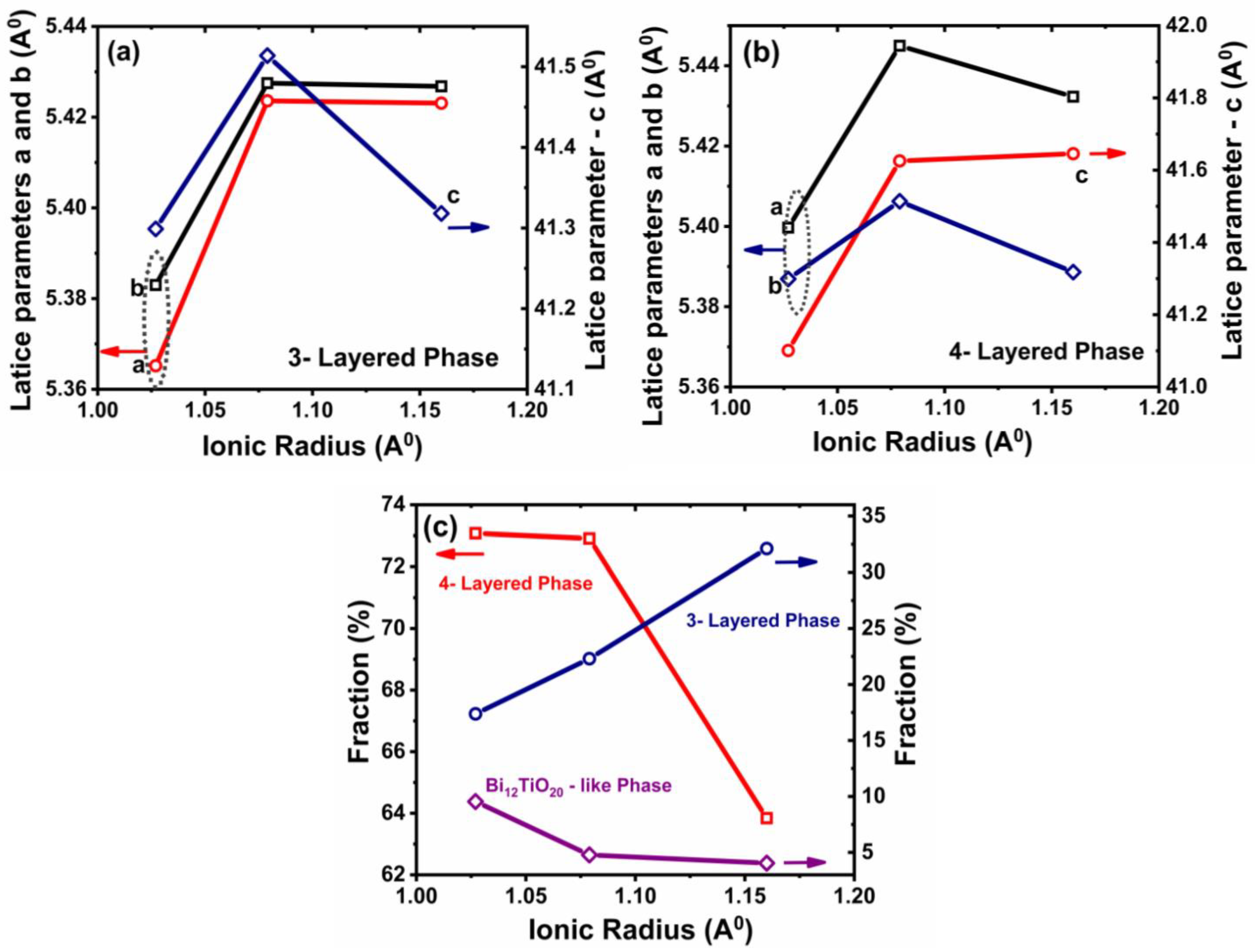

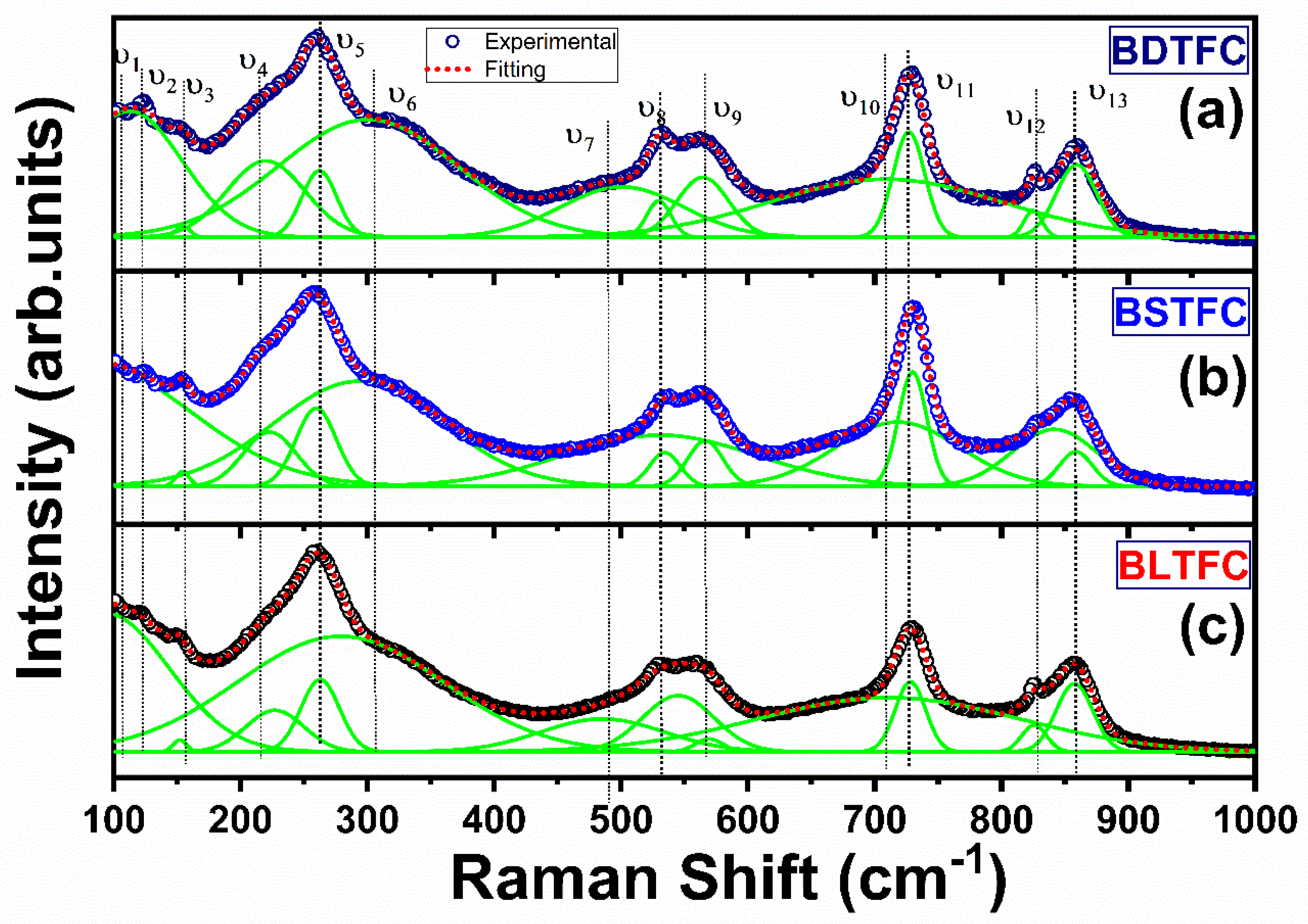

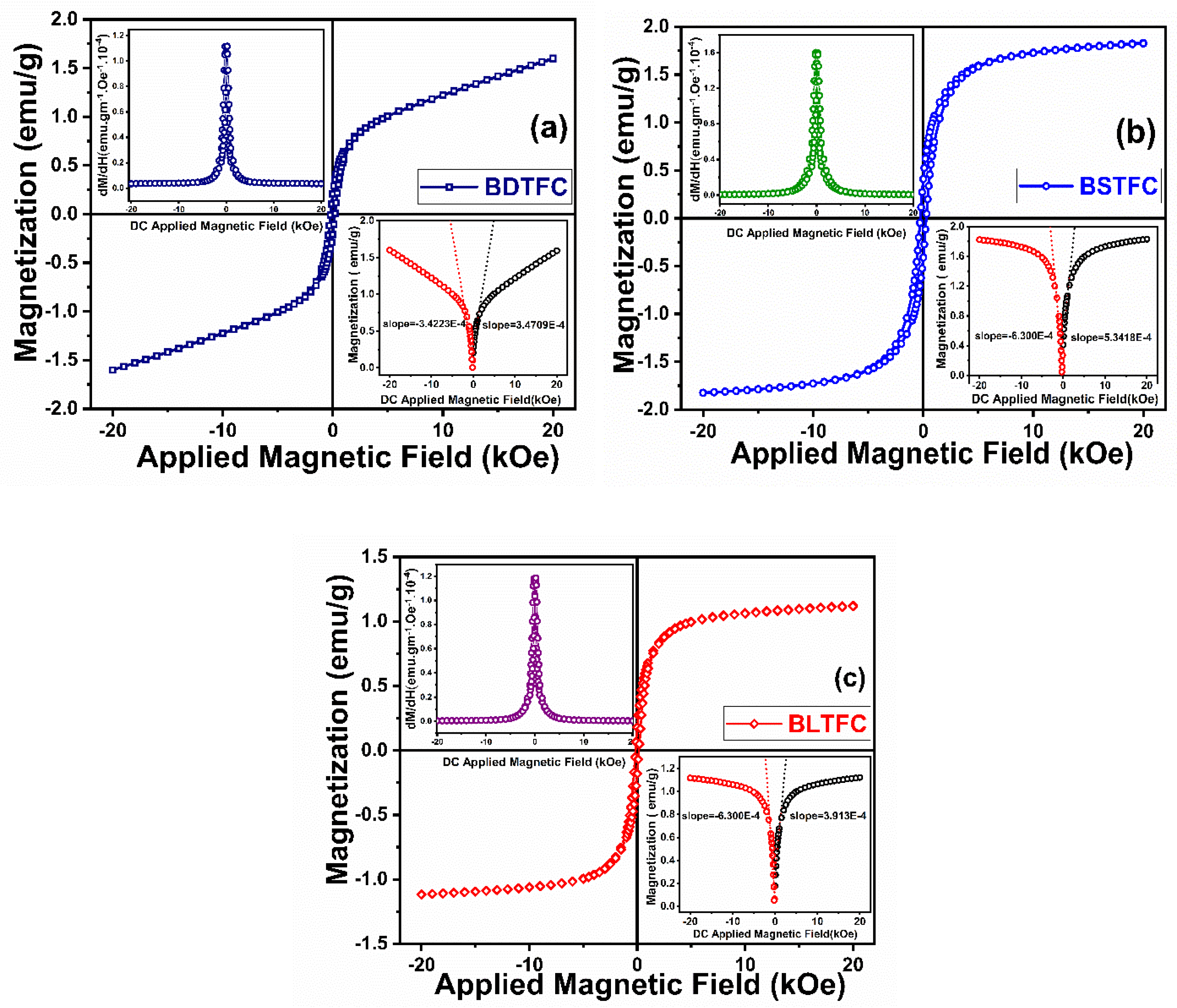
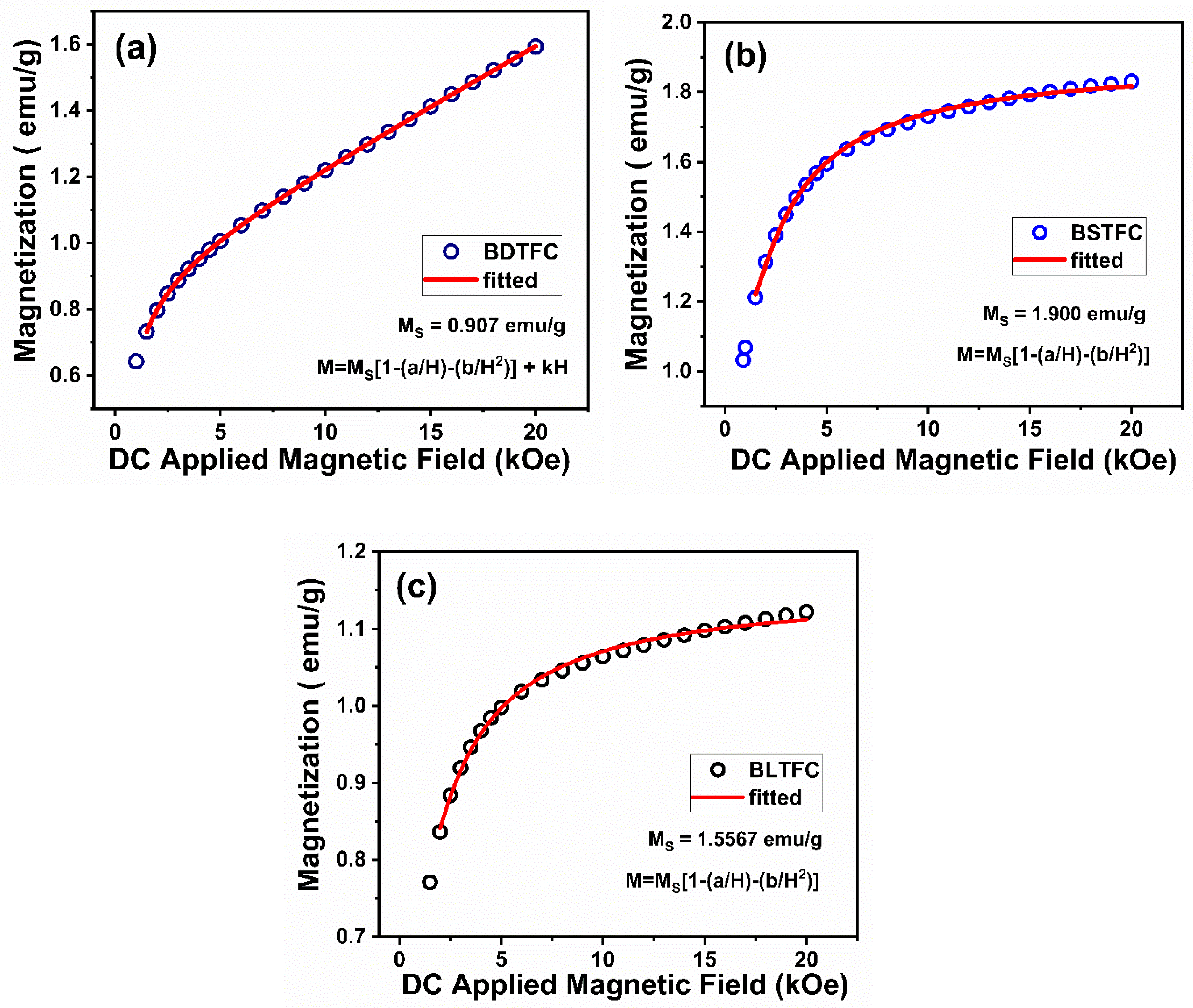

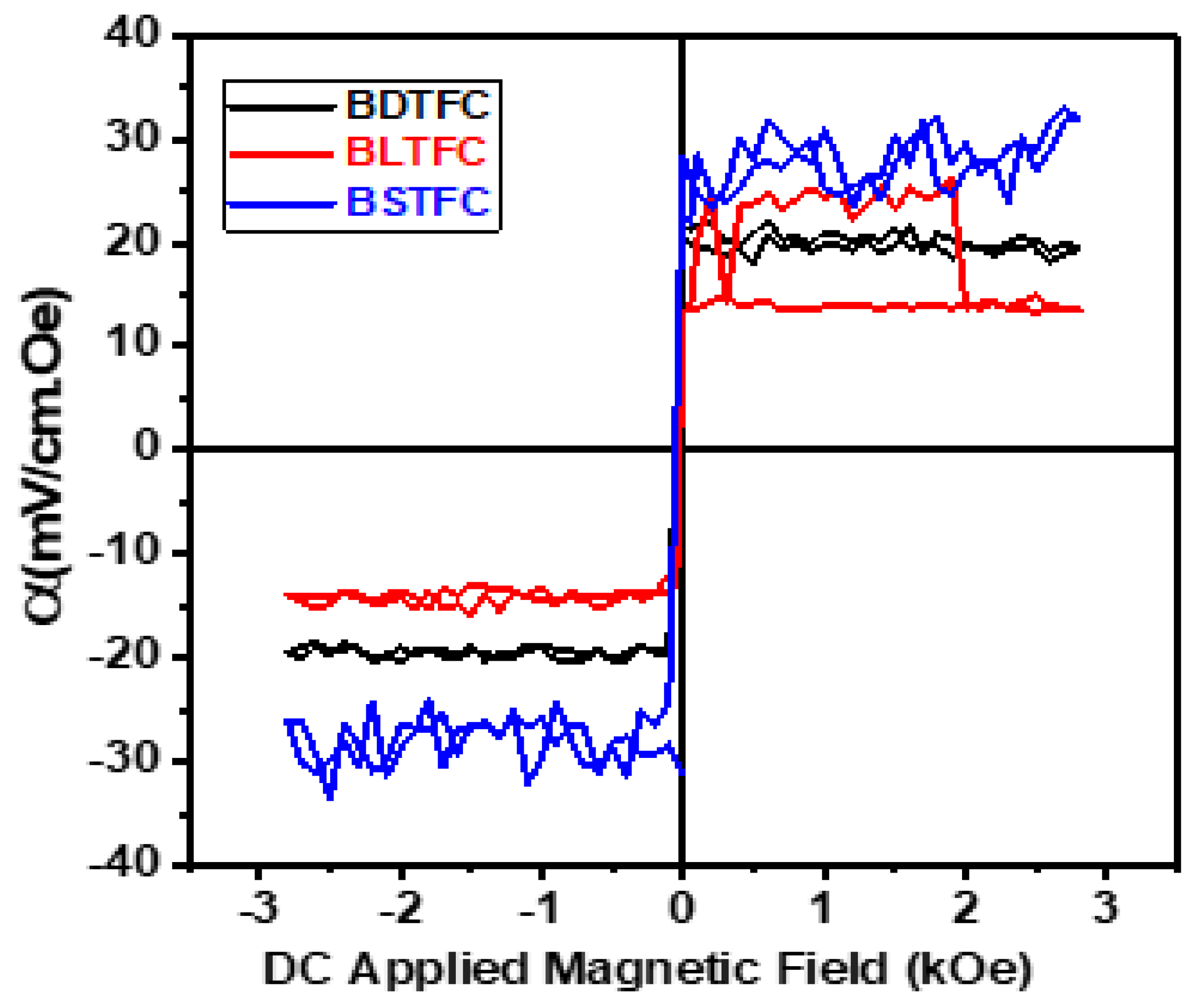
Disclaimer/Publisher’s Note: The statements, opinions and data contained in all publications are solely those of the individual author(s) and contributor(s) and not of MDPI and/or the editor(s). MDPI and/or the editor(s) disclaim responsibility for any injury to people or property resulting from any ideas, methods, instructions or products referred to in the content. |
© 2023 by the authors. Licensee MDPI, Basel, Switzerland. This article is an open access article distributed under the terms and conditions of the Creative Commons Attribution (CC BY) license (https://creativecommons.org/licenses/by/4.0/).
Share and Cite
Veenachary, V.; Ramana, E.V.; Babu, S.N.; Puli, V.S.; Srinivas, A.; Srinivasan, G.; Saha, S.; Prasad, G.; Prasad, N.V. Magnetic and Magnetoelectric Properties of AurivilliusThree- and Four-Layered Intergrowth Ceramics. Crystals 2023, 13, 426. https://doi.org/10.3390/cryst13030426
Veenachary V, Ramana EV, Babu SN, Puli VS, Srinivas A, Srinivasan G, Saha S, Prasad G, Prasad NV. Magnetic and Magnetoelectric Properties of AurivilliusThree- and Four-Layered Intergrowth Ceramics. Crystals. 2023; 13(3):426. https://doi.org/10.3390/cryst13030426
Chicago/Turabian StyleVeenachary, Vadla, Eskilla Venkata Ramana, Simhachalam Narendra Babu, Venkata Sreenivas Puli, Adiraj Srinivas, Gopalan Srinivasan, Sujoy Saha, Guduru Prasad, and Nandiraju Venkata Prasad. 2023. "Magnetic and Magnetoelectric Properties of AurivilliusThree- and Four-Layered Intergrowth Ceramics" Crystals 13, no. 3: 426. https://doi.org/10.3390/cryst13030426
APA StyleVeenachary, V., Ramana, E. V., Babu, S. N., Puli, V. S., Srinivas, A., Srinivasan, G., Saha, S., Prasad, G., & Prasad, N. V. (2023). Magnetic and Magnetoelectric Properties of AurivilliusThree- and Four-Layered Intergrowth Ceramics. Crystals, 13(3), 426. https://doi.org/10.3390/cryst13030426








